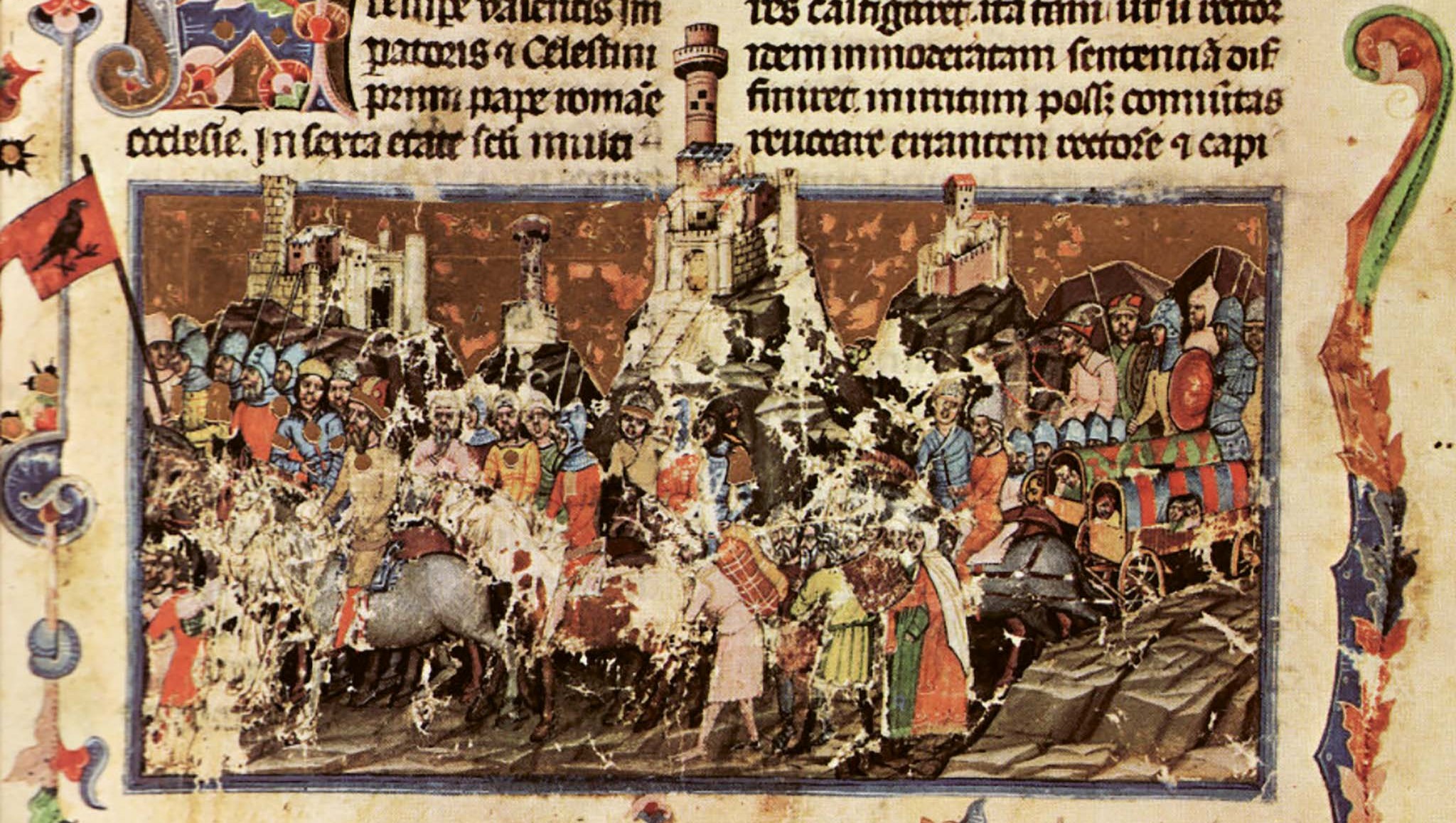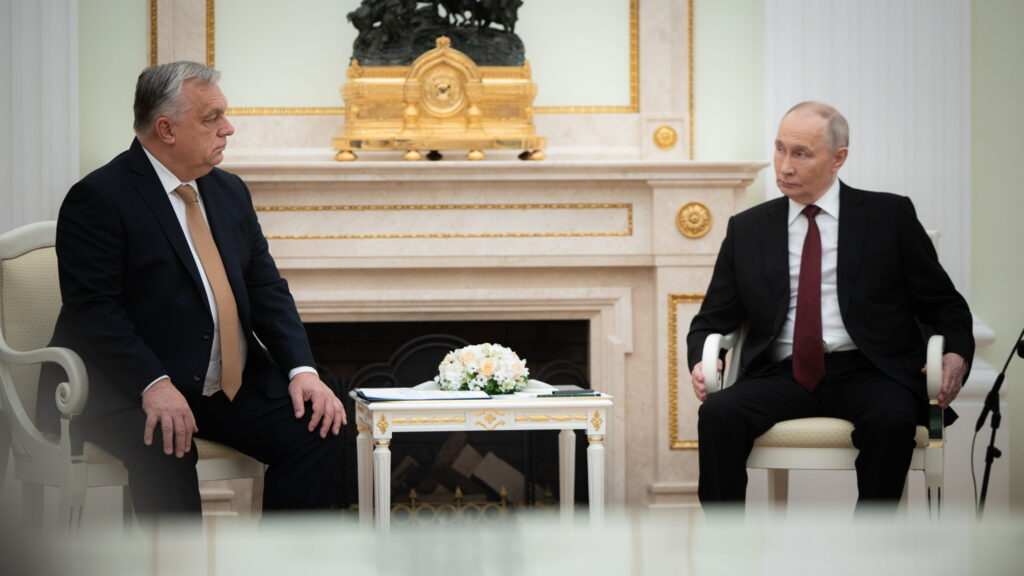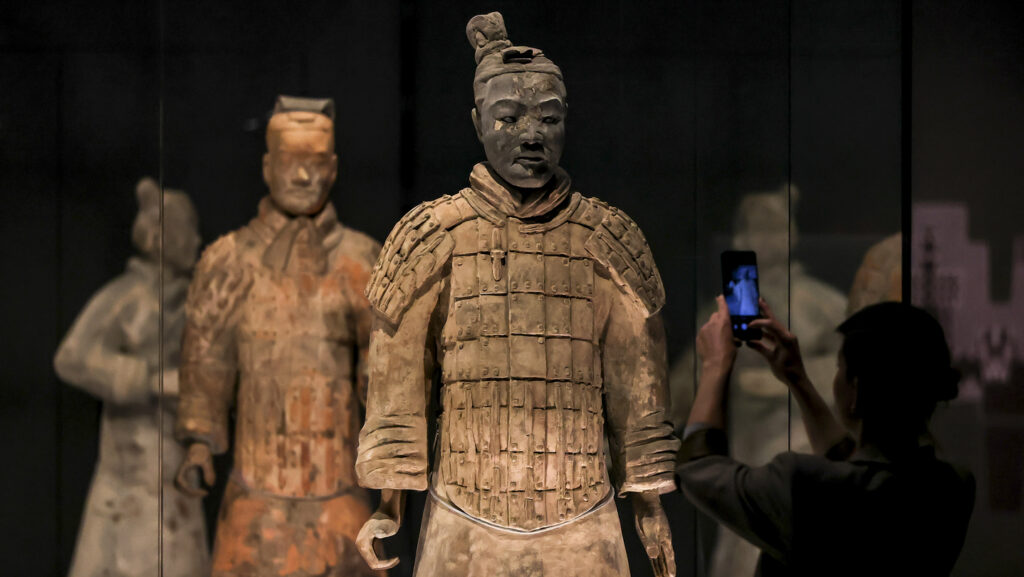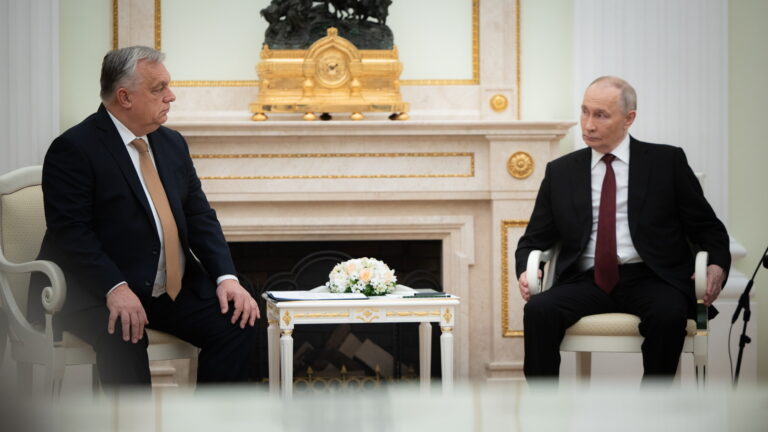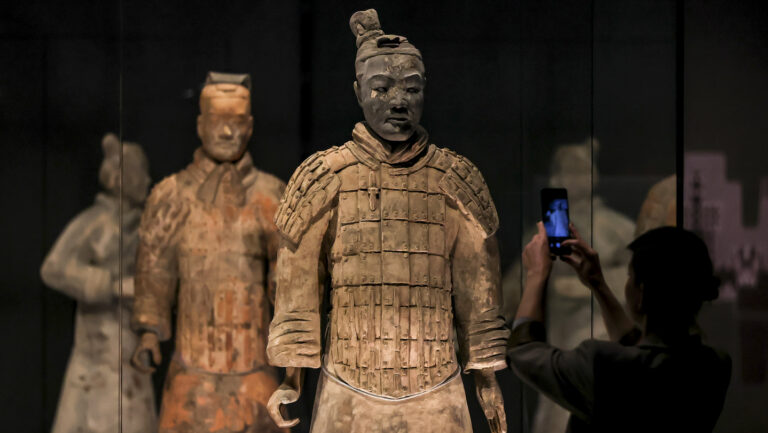This article was originally published in Vol. 5 No. 2 of our print edition.
Hungary as a Gateway for the US and the EU into the Turkic Silk Road Region
Introduction
Hungary’s history and geography have always positioned it as a gateway between Europe and the wider East, as well as a bridge for the East to access the West. Throughout its past, the country has often found itself at a crossroads, bordered by Catholic empires to the west and Orthodox nations to the south and east. It also served as a stronghold against nomadic and Muslim invasions, playing a pivotal role in protecting Europe’s heartland. This strategic position can be traced back to the time of the Huns, who entered Europe and eventually reached the gates of Rome, securing the Carpathian Basin for future Hungarians. Similarly, Hungary withstood the Mongol invasions, and the Mongols’ retreat in 1242 marked a historic turning point, only to be followed in 1541 by Ottoman subjugation, the trisection of the Kingdom of Hungary, and some 150-year of Ottoman rule until in 1699 the country was liberated by the Habsburgs—who would remain in control of Hungary until 1918.
Such continuous interactions with contrasting civilizations have shaped Hungary into a connecting force, capable of understanding and engaging effectively with diverse cultures. This legacy is reflected in Hungary’s contemporary foreign policy, which balances strong ties with the United States, support for the EU’s expansion into the Western Balkans, and its ‘Eastern Opening’ policy, which includes fostering relations with the Turkic states.
While this has been a historical feature of Hungary, its revival has been particularly noticeable since 2010, with the emphasis on greater engagement with countries to the East, beyond the EU. The Eastern Opening policy was introduced by Hungary’s current leader, Viktor Orbán, who captured its essence with a memorable statement following his re-election. During a speech on 5 November 2010, he declared: ‘We sail under a Western flag, but in the global economy, the wind is blowing from the East.’1 This marked a significant shift in Hungary’s foreign policy, becoming a turning point in its relations with the member states of the former Turkic Council, now the Organization of Turkic States (OTS), which at the time included Türkiye, Azerbaijan, Kazakhstan, and Kyrgyzstan as its core members. Hungary itself gained observer status in the organization in 2018.
The Increasing Importance of the Region
The Turkic Council was established in 2009 with the signing of the Nakhchivan Agreement, with the aim of enhancing cooperation between Turkic-language-speaking states. Over the past decade, the organization has significantly expanded its scope and influence, culminating in its rebranding as the Organization of Turkic States (OTS). This transformation was formalized through a joint declaration adopted during the eighth Summit in Istanbul, Türkiye.2 At the same summit, the ‘Turkic World 2040’ vision was introduced, paving the way for broader cooperation and deeper institutionalization among member states, which is crucial for higher value-added production in the region. This underlies its greater economic development.
The organization’s evolution has been closely tied to geopolitical changes in the South Caucasus, a crucial linking region. A major turning point occurred after the Second Karabakh War in 2020, which created conditions for potential peace negotiations between Armenia and Azerbaijan, and the finalization of the text of the peace agreement in 2025. This development significantly enhanced the strategic value of the South Caucasus as a transit hub connecting Europe and Central Asia.
The importance of this region grew further with the onset of the Russia–Ukraine War in February 2022. The crisis effectively elevated the Trans-Caspian trade route to the status of the safest and most reliable corridor for commerce between the European Union and Central Asia. The EU’s comprehensive sanctions on Russia had severe economic consequences, placing stress not only on the Russian economy but also on European industries. The sharp reduction in Russian oil and natural gas imports led to soaring energy prices across the EU, exacerbating trade imbalances and leading to rising costs.
‘Hungary is increasingly emerging as a gateway between the West and the Turkic world’
As a result, many EU countries were compelled to seek alternative trade routes and partners. Central Asia, with its rapidly growing population and expanding economies, emerged as a key region for the EU to diversify its trade relations and reduce its dependence on traditional sources. With their rapidly growing populations, Turkic countries, particularly those in Central Asia, offer growing consumer markets that present an effective alternative to the Russian consumer market. With this in mind, however, the local economies need to be further industrialized, enabling higher value-added production to ensure a fair exchange of value, whereby both parties gain the desired outcome. As part of this process, Hungary’s decade-long Eastern Opening policy will play a pivotal role, as it has positioned the country as the EU member state with one of the strongest connections to the Turkic world.
Hungary’s Strategic Relations with the Region
Hungary’s involvement in the Turkic region is multidimensional, encompassing political, economic, business, and cultural cooperation. Over the past fifteen years, the country has steadily elevated its relations with all five member states of the OTS to the level of a strategic or enhanced strategic partnership.
In 2014, Hungary signed a strategic partnership agreement with Kazakhstan,3 followed by a similar agreement with Uzbekistan4 in 2021 during the official visit of the Hungarian prime minister to Tashkent. Relations with Azerbaijan,5 Kyrgyzstan,6 and Türkiye7 have also been strengthened, with Hungary establishing ‘enhanced strategic partnerships’ with the first two and a ‘priority strategic partnership’ with Türkiye. These partnerships have been formalized through a series of joint declarations and agreements, most notably in January 2023, at the 2024 OTS Summit in Bishkek, and through an agreement signed in Budapest in December 2023, respectively.

During the signing ceremony with the Turkish President, Hungary’s prime minister declared: ‘Turks and Hungarians will be winners together in the 21st century.’8 While this statement underlined the strength of bilateral relations between Hungary and Türkiye, it also subtly pointed to a broader trend in the Silk Road region: the rise of keystone states—notably Hungary, Azerbaijan, Kazakhstan, and Uzbekistan. The latter three countries, through coordinated efforts, are poised to become the principal drivers of trade along the Trans-Caspian route, setting the terms of trade for the region. Hungary’s alignment with this emerging axis positions it as a vital link between the Turkic world and Europe, shaping interregional trade and economic dynamics.
Data from the Hungarian Central Statistical Office (KSH) reveals that since the launch of the country’s Eastern Opening policy, Hungary’s total trade turnover with current OTS member states—Türkiye, Azerbaijan, Kazakhstan, Uzbekistan, and Kyrgyzstan— had increased more than 5.5 times by 2023.9
However, Hungary’s economic engagement with the region goes far beyond trade. Its presence is rooted in strong multisectoral business ties, reflecting a long-term commitment to mutual growth and economic resilience. Major Hungarian companies such as MOL and MVM (energy), Richter (pharmaceuticals), and OTP Bank have become key players in regional markets. Apart from energy projects within its own borders, Hungary is also a participant in the development of the Black Sea power line, which will run from Azerbaijan through Georgia, across the Black Sea, and through Romania, ultimately reaching Hungary.10 The project is expected to be completed by the end of this decade. It is significant because this line is planned to connect with the future Caspian Sea power line, making it the largest ‘green energy’ initiative in Europe. The transmission line will bring clean, green energy from Central Asia and Azerbaijan to Hungary, positioning the country as a strategic hub for the distribution of renewable energy within the EU. These ventures not only represent Hungary’s strategic economic outreach but also foster interdependence, trust, and continuous development across sectors.
Hungary is increasingly emerging as a gateway between the West and the Turkic world, and vice versa, bridging continents through trade, diplomacy, and shared interests. In the following sections, this article will explore the nuances of Hungary’s economic and business ties with the Turkic Silk Road countries, offering a comprehensive understanding of the evolving dynamics.
Hungarian Economic and Business Presence in Turkic States
Azerbaijan
Energy cooperation is just one facet of the deepening relationship between Hungary and Azerbaijan. As Hungarian Foreign Minister Péter Szijjártó emphasized during a meeting with his Azerbaijani counterpart, Jeyhun Bayramov, in Budapest: ‘Our friendship is not solely based on the fact that you have natural gas.’ He highlighted the continuous growth in bilateral trade—progress that began well before natural gas exports—and underscored the crucial role Hungarian companies play in Azerbaijan’s development, which in turn supports Hungary’s own economic advancement.
This evolving partnership was further solidified with the signing of the Joint Declaration on Enhanced Strategic Partnership in January 2023 by Hungarian Prime Minister Viktor Orbán and Azerbaijani President Ilham Aliyev, laying the new foundation for deeper economic and political ties.
Trade turnover between the two countries is expected to grow significantly following new agreements reached at the Hungary–Azerbaijan Business Forum in April 2024. Notably, Azerbaijan’s Minister of Labour and Social Protection announced a 40.49-per-cent increase in trade volume during January–February 2024, compared to the same period in 2023.11 A key driver of this growth has been the successful presence of Hungarian enterprises in Azerbaijan.
Hungarian energy giants MVM and MOL play pivotal roles: MVM ensures reliable natural gas deliveries to Hungary, while MOL is actively involved in modernizing extraction technologies and enhancing the chemical industry in Azerbaijan. Within this context it is important to mention that MOL Group has a 9.57-per-cent stake in the Azeri–Chirag–Gunashli oil field and 8.9-per-cent stake in the Baku–Tbilisi–Ceyhan pipeline, which are essential for Azerbaijan’s oil exports globally.12 Also, in August 2024, MVM Group acquired a 5-per-cent share in one of the world’s largest offshore natural gas fields, Shah Deniz, in Azerbaijan, by closing a deal with the Azerbaijani state-owned entity Southern Gas Corridor CJSC.13
‘The Turkic countries of the Silk Road are gaining unprecedented strategic importance’
Beyond energy, Hungary’s contribution extends to the pharmaceutical sector, with Richter, a leading Hungarian pharmaceutical company, signing contracts to produce 90 medicines locally in Azerbaijan. Additionally, the iconic Hell energy drink brand is set to establish a manufacturing plant in Azerbaijan to meet rising local demand. The April 2024 forum gathered 55 companies across diverse fields—including agriculture, ICT, water management, healthcare, construction, finance, and the automotive sector—reflecting the broad scope of this cooperation. To further facilitate Hungarian ventures in Azerbaijan, Hungary introduced an Asian Investment Fund and a €50 million credit line through Eximbank, with the possibility of expanding this amount up to threefold.
Hungary has also taken a supportive role in Azerbaijan’s post-conflict reconstruction efforts in Karabakh. The Hungarian government contributed €10,000 toward demining operations and is involved in the reconstruction of Soltanli village, showcasing its commitment to humanitarian and infrastructural development. During his 2024 visit to Baku, Hungary’s foreign minister expressed support for the ongoing Armenia–Azerbaijan peace process and emphasized Hungary’s role in promoting regional stability.14
Kazakhstan
Hungary stands as one of Kazakhstan’s key Western partners, a relationship rooted in early diplomatic recognition and sustained by decades of collaboration. Notably, Kazakhstan’s first European embassy was established in Budapest, and Hungary was among the first countries to recognize Kazakhstan’s independence. In 2024, the two nations celebrated a decade since the elevation of their ties to a strategic partnership, underscoring the maturity and depth of their bilateral relationship.
This strategic partnership has been significantly bolstered by growing economic cooperation. During Kazakh President Kassym-Jomart Tokayev’s 2024 official visit to Budapest, he participated in an investment roundtable alongside Hungarian and Kazakh business leaders. He noted the presence of over 70 active Hungarian companies operating in Kazakhstan, with Hungarian investments totalling $370 million since 2005. A new mutual investment strategy worth $540 million, targeting sectors such as logistics, agriculture, and mechanical engineering, is currently under development, pointing to even greater future potential.15
Trade between the two nations has also surged, with bilateral trade turnover doubling between 2014 and 2023. President Tokayev emphasized during a joint press briefing the shared goal of reaching $1 billion in trade volume. He also highlighted that Kazakhstan currently exports 95 types of goods to Hungary, amounting to over $700 million, a figure that reflects both diversification and growth potential in economic ties.16
Flagship Hungarian companies such as MOL Group and Richter Gedeon exemplify this collaboration. MOL, through its joint venture Uralsk Oil and Gas (UOG) with KazMunayGas EP and FIOC, is actively engaged in the Rozhkovskoye gas-condensate field. In December 2023, MOL began producing 300,000 cubic meters of gas daily at the site, marking a milestone in Hungarian–Kazakh energy cooperation. At the same time, Richter Gedeon continues to contribute to the advancement of Kazakhstan’s healthcare sector, underlining the multi-sectoral nature of the partnership.17
Energy cooperation is rapidly evolving, extending beyond hydrocarbons into renewable energy initiatives. During a bilateral meeting with Prime Minister Viktor Orbán ahead of the 10th Summit of the Organization of Turkic States (OTS) in Astana, President Tokayev received praise from Hungary’s foreign minister for the steady growth of bilateral ties. A notable achievement was the conversion of the Kazakh city of Taraz to green energy, a project completed with the help of MOL Group. Hungary and Kazakhstan are now aiming to increase oil shipments to 630 tons, further highlighting the strategic scope of their energy agenda.18
Uzbekistan
Since Uzbekistan’s independence, Hungary has been a dynamic partner in developing strong political, economic, and trade relations with the country. Hungary was among the first nations to recognize Uzbekistan’s sovereignty, and ties have deepened significantly in recent years, especially following Hungary’s acquisition of observer status and Uzbekistan’s full membership in the Organization of Turkic States (OTS) in 2018. These institutional connections have contributed to a rapid expansion of bilateral cooperation.
Trade figures reflect the growing momentum. In the 13 years since the launch of Hungary’s Eastern Opening policy, bilateral trade turnover between Hungary and Uzbekistan has quadrupled. Notably, two-thirds of this trade growth has taken place since both countries intensified their engagement with the OTS in 2018, with trade volume tripling between 2018 and 2023. In May 2024, Hungarian Minister of Foreign Affairs and Trade Péter Szijjártó visited Tashkent and held high-level talks with President Shavkat Mirziyoyev. The visit coincided with a business forum, where 137 B2B and G2B meetings19 were held to expand the footprint of Hungarian companies in Uzbekistan. These sessions spanned a broad range of sectors, including water management, mechanical engineering, banking, finance, agriculture, transportation, and logistics.20
‘Hungary is the only country in the world that maintains institutional ties with both the West, through the EU and NATO, and the Turkic World, through the Organization of Turkic States’
Hungarian corporate engagement in Uzbekistan has reached a new level of strategic investment. A landmark example is OTP Bank’s purchase of a majority stake (73.71 per cent) in Ipoteka Bank, the fifth largest bank in Uzbekistan, previously operated by the Uzbek Ministry of Economy and Finance. This acquisition underscores the growing role of Hungarian financial institutions in Uzbekistan’s economic modernization. Hungarian firms such as OTP Group, Joyson Safety Systems, and Bonafarm have launched projects in Uzbekistan totalling approximately $500 million. Meanwhile, the Association of Hungarian Light Industry (AHLI), a member of the European Confederation of Clothing and Textiles since 2004, has facilitated closer industrial cooperation, particularly in the leather and textile sectors. The initiative envisions the partial outsourcing of Hungary’s textile, leather, clothing, and footwear production to Uzbekistan, in alignment with Uzbekistan’s industrial expansion goals. Notably, the value of Uzbekistan’s leather and footwear industry has surged from $90 million to $450 million, with further growth anticipated.21
A standout example of how Hungarian–Uzbek cooperation fosters not only economic growth but also innovation and knowledge transfer is the joint development of several pharmaceutical products based on an anti-malarial active ingredient. This compound, recognized with the 2015 Nobel Prize in Physiology or Medicine—has proven applications in cancer therapy and has now become central to a Hungarian–Uzbek R&D&I (Research, Development, and Innovation) initiative. The project focuses on creating a diverse range of products through comparative studies, including antiseptic and anti-inflammatory lozenges, hard capsules, hydrogels, ointments, ear drops, mouthwashes, and refillable patches designed for the treatment of ulcers and large wounds. This groundbreaking collaboration is being carried out by the Tashkent Pharmaceutical Institute in Uzbekistan and MEDITOP Pharmaceuticals Ltd, a leading Hungarian pharmaceutical firm that opened its representation office in Uzbekistan in 2023.22 This initiative underscores the growing depth of bilateral ties, with innovation and medical research emerging as promising new frontiers.
Kyrgyzstan
Collaboration between Hungarian and Kyrgyz companies has gained significant momentum through the work of the Hungarian–Kyrgyz Development Fund, a key institutional mechanism fostering bilateral economic engagement. Currently, the fund brings together 98 member companies, including 31 Hungarian and 67 Kyrgyz firms, collaborating across a wide array of sectors.23 This reflects the increasingly diverse and strategic nature of economic cooperation between the two nations.
The Hungarian–Kyrgyz Development Fund was established under a landmark agreement signed on 11 July 2017, in Mauerbach, Austria, during which the Agreement on Economic Cooperation and a Memorandum of Understanding were concluded by the foreign ministers of both countries. Anchored in Article 3 of the Economic Cooperation Agreement,24 the Fund exemplifies Hungary’s commitment to strengthening its bilateral relationship with Kyrgyzstan while contributing to the sustainable socioeconomic development of the region.
Designed to mobilize additional financial resources, the Fund supports initiatives aligned with long-term development goals in Kyrgyzstan. It plays a pivotal role in areas such as manufacturing, mining, metallurgy, infrastructure, agro-industry, trade, water management, information technology, science, research, and innovation. Through these sectors, Hungarian companies are making significant contributions not only to economic growth but also to capacity building and knowledge transfer.25
This collaboration demonstrates Hungary’s growing role as a trusted Western partner of Kyrgyzstan and underscores its strategic interest in enhancing regional connectivity and prosperity. The Hungarian–Kyrgyz Development Fund continues to serve as a vital platform, enabling robust B2B engagement and reinforcing the shared vision of sustainable development between the two nations.
Turkmenistan
Within the framework of Hungary’s Eastern Opening policy, cooperation with Turkmenistan has developed markedly, driven by shifting dynamics in the broader Silk Road region. As geopolitical and economic conditions evolve, Hungary has positioned itself as a proactive partner in engaging with Turkmenistan across multiple sectors.
Hungary is already among the largest pharmaceutical suppliers in the Turkmen market, and the contributions of Hungarian firms in this domain are increasingly recognized.26 However, there remains untapped potential for further collaboration, especially as both sides seek to expand cooperation in new sectors. One such emerging area is water management, a critical concern for Central Asia amid increasingly prevalent drought conditions.27 Hungary, with its technical expertise, is enhancing its cooperation with Turkmenistan in this field, and future investments are expected to grow significantly.
While Hungarian–Turkmen trade has shown a steady upward trajectory over the past decade, its full potential is yet to be realized. Relations received a considerable boost in June 2023, when Hungarian Prime Minister Viktor Orbán visited Ashgabat, resulting in the signing of a series of bilateral agreements spanning economic, political, diplomatic, cultural, and humanitarian cooperation.
Turkmenistan, home to the fourth-largest natural gas reserves in the world, estimated at 13.4 trillion cubic metres, has long been seen as a potential energy partner for Europe.28 Although the long-discussed Trans-Caspian Pipeline project remains stalled due to political complexities, a significant breakthrough occurred in August 2020. During this period, Hungary became the first European country to sign a gas delivery agreement with Turkmenistan, envisioning the supply of up to 1 billion cubic metres (bcm) of natural gas. This agreement not only marks a milestone in bilateral energy cooperation but also positions Hungary as a potential gateway for Turkmen gas into the European market. As energy diversification becomes an increasingly urgent strategic priority for Europe, Hungary’s role as a facilitator of East–West energy transit is gaining importance.
Critical Minerals in the Region and Hungary’s Potential Role
With the return of Donald Trump to the US presidency, economic independence and the need to reduce China’s dominance over critical mineral supply chains have once again risen to the top of Washington’s strategic agenda. Although concerns about China’s control of these vital resources have existed for years, it is under Trump’s leadership, especially in his second term, that the issue has gained unprecedented visibility. The United States is now actively pursuing the diversification of its critical mineral sources, seeking alternative suppliers across the globe to ensure resilient and secure economic growth.
A major milestone in this effort was the Energy Act of 2020, signed during Trump’s first term.29 This legislation formally defined ‘critical minerals’ as essential to the nation’s economic and national security and emphasized the urgent need to diversify their origin. These minerals, including copper, lithium, nickel, cobalt, and rare earth elements, are indispensable components of cutting-edge energy technologies such as wind turbines, power grids, and electric vehicles.30 As global energy transition efforts accelerate, the demand for these materials is rising sharply, not just in the US, but across the EU as well, which is heavily investing in its Green Deal initiatives.
This growing demand naturally raises a key question: where will the world find new, reliable sources of critical minerals? The answer increasingly points to the Silk Road region, particularly Central Asia, which is emerging as a pivotal supplier of these strategic resources. Kazakhstan, for instance, boasts substantial reserves: 6.7 million tons of zinc, the 7th largest globally, 20 million tons of copper, 11th, 2 million tons of lead, 8th, and 1.5 million tons of nickel, which is in the top 20 globally.31 Mining represents 29 per cent of the country’s industrial output, the second largest output in the country, and contributes 7 per cent to GDP, employing more than 80,000 people.32
Uzbekistan is another critical player, as it is rich in germanium, silicon, and several rare earth elements. The country ranks among the world’s top 10 producers of uranium, rhenium, and tellurium; top 15 for copper; and top 20 for molybdenum and cadmium.33 In 2025, Uzbekistan unveiled a $2.6 billion strategy to unlock its mineral wealth, with 76 projects targeting 28 critical elements. This ambitious three-year plan includes the development of tungsten, lithium, titanium, and vanadium deposits, all vital for modern industries, including nuclear energy.34
Kyrgyzstan also holds significant promise. At the tenth ‘MINEX Central Asia’ forum held in Bishkek on 19 June 2024, the prime minister highlighted enormous reserves: approximately 20 million tons of titanomagnetite at Kyzyl-Ompol and around 60,000 tons of rare earth elements, including over 21 distinct metals, at Kutessay-2. Over 100 companies from 22 countries, including China, Europe, and North America, participated in the forum, signalling rising international interest in the region.35
Turkmenistan, while still in the early stages of exploration, is believed to possess valuable reserves of sulphur, bromine, and iodine, key components in various clean energy applications.36
‘Hungary’s consistent diplomatic support and economic cooperation have earned it a high level of trust in the region’
What sets Central Asia apart in the global mining landscape is not only its resource richness but also its favourable conditions for development. The region’s steppe and desert environments pose minimal environmental disruption, making large-scale mining more feasible. Furthermore, Kazakhstan, Uzbekistan, and Kyrgyzstan offer investor-friendly legal frameworks, a skilled and educated labour force, and legacy infrastructure dating back to the Soviet era, when industrial-scale mineral extraction was already well established. European firms have taken note and are moving swiftly to secure stakes in the region. Now is the time for US companies to act with equal urgency.
Central Asian countries are eager for foreign investment to capitalize on their mineral wealth. Here, Hungary can play a unique role as a strategic bridge linking American investors to opportunities in the Silk Road region. By facilitating these connections, Hungary could not only boost regional development but also position itself as a stakeholder in critical mineral value chains, securing mutual economic gains.
Conclusion
Amid today’s increasingly complex and competitive global geopolitical environment, the Turkic countries of the Silk Road are gaining unprecedented strategic importance. Positioned at the intersection between Russia, China, and Türkiye, and bordering the EU, together these nations are emerging as one of the vital regions in international affairs. These include Azerbaijan and Turkic Central Asian countries such as Kazakhstan, Uzbekistan, Kyrgyzstan, and Turkmenistan, with Azerbaijan holding a particularly important geographic position that allows for the bypassing of unstable regions on the way to the rapidly growing Central Asian market.
As global divisions deepen and the search for alternative markets intensifies, this region is set to become increasingly valuable to Western economies. It offers a combination of a well-educated population, vast reserves of natural resources, and strong potential for industrial growth. These advantages make the Turkic countries natural economic partners for the EU and highly relevant to US foreign-policy goals.
Recognizing their growing importance, the Turkic countries of the Silk Road region, together with Türkiye, have initiated regional cooperation through the Organization of Turkic States (OTS). Established in 2009 under the Nakhchivan Agreement as the Turkic Council, a primarily cultural initiative, the organization has since evolved into a key forum for political, economic, and trade coordination. A turning point came at the Istanbul Summit in 2021, where the organization adopted the name OTS and unveiled the ‘Turkic World 2040’ vision, marking a strategic commitment to deeper integration.
Hungary was among the first EU countries to seize this opportunity. Under Prime Minister Viktor Orbán’s Eastern Opening policy, launched during his second term, Hungary has spent over 15 years fostering close ties with the Turkic world. The results have been remarkable: trade between Hungary and OTS member states has increased 5.5 times. Hungary became an observer at the OTS in 2018 and, in 2019, opened the organization’s only office within the EU, positioning itself as a key bridge between the West and the Turkic World. Hungary is the only country in the world that maintains institutional ties with both the West, through the EU and NATO, and the Turkic World, through the Organization of Turkic States (OTS).
It maintains strategic relations with Kazakhstan and Uzbekistan, enhanced strategic relations with Azerbaijan and Kyrgyzstan, and a priority strategic partnership with Türkiye. What distinguishes Hungary is its respect for local needs in shaping partnerships. The Turkic countries are in search of investment and cooperation that support industrial development and value-added production. With abundant resources and growing consumer markets, these nations present an attractive alternative for Western economic engagement. Hungary’s success offers a valuable model for building enduring and mutually beneficial relations.
Hungarian companies have already established a strong presence in the region. Leading firms such as MOL and MVM, Richter Gedeon, and OTP Bank operate in multiple Turkic states. Hungarian universities collaborate with institutions in countries like Uzbekistan to support innovation and the transfer of knowledge. In areas such as environmental sustainability, Hungarian firms are contributing through technologies in fields like irrigation.
Another major factor increasing the region’s significance is its wealth of critical and rare earth minerals. As the US and EU seek to reduce dependency on Chinese critical and rare earth minerals, the Turkic countries, with their investor-friendly policies, skilled workforces, and substantial resources, are becoming increasingly attractive. Hungary can play a key role by facilitating the greater entry of US and European investors into this promising market, particularly in Central Asia.
Hungary’s consistent diplomatic support and economic cooperation have earned it a high level of trust in the region. Today, it functions as a crucial entry point for the West into the Turkic Silk Road and can offer a platform for deeper engagement and economic collaboration. With its established partnerships and extensive experience, Hungary is well-positioned to help other Western countries effectively engage with the dynamic and increasingly growing Turkic market.
NOTES
1 ‘Tárgyilagos és realista nemzetpolitikára van szükség’ (Objective and Realist National Policy is Needed), Kormányportál (5 November 2010), https://2010-2014.kormany.hu/hu/miniszterelnokseg/ hirek/targyilagos-es-realista-nemzetpolitikara-van-szukseg.
2 Mehmet Sah Yilmaz, ‘Turkic Council’s Name Changed to Organization of Turkic States’, Anadolu Agency (13 November 2021), www.aa.com.tr/en/world/turkic-council-s-name-changed-to-organization-of-turkic-states/2419633.
3 Ministry of the Economy, ‘Kazakhstan Is Hungary’s Strategic Partner in Central Asia’, Kormány.hu (3 June 2014), https://2010-2014.kormany.hu/en/ministry-for-national-economy/news/kazakhstan-is-hungary-s-strategic-partner-in-central-asia.
4 Ibrahim Mammadov, ‘Hungary and Uzbekistan Tighten Economic and Atomic Energy Cooperation’, Hungarian Conservative Online (28 May 2024), www.hungarianconservative.com/articles/current/hungary_uzbekistan_partnership_economy_atomic-energy/.
5 Office of the President of Azerbaijan, Ilham Aliyev, ‘Azerbaijan, Hungary Signed Documents’, President.az (30 January 2023), https://president.az/en/articles/view/58755.
6 Abdullo Janob, ‘Kyrgyzstan Signs Declaration on Expanded Strategic Partnership with Hungary’, Trend.az (5 November 2024), https://en.trend.az/casia/kyrgyzstan/3965630.html.
7 Viktor Orbán, ‘Turks and Hungarians Will Be Winners Together in 21st Century’. From a speech given on 18 December 2023. Available at: https://miniszterelnok.hu/en/turks-and-hungarians-will-be-winners-together-in-21st-century/.
8 Viktor Orbán, ‘Turks and Hungarians Will Be Winners Together in 21st Century’.
9 Hungarian Central Statistical Office, ‘National Accounts, GDP’, KSH.hu, www.ksh.hu/stadat_eng?lang=en&theme=gdp, accessed 20 April 2025.
10 ‘Black Sea Submarine Cable Project’, GSE, www.gse.com.ge/projects/international-projects/Black-Sea-Submarine-Cable-Project, accessed 20 April 2025.
11 Ibrahim Mammadov, ‘Enhanced Strategic Partnership in Energy and Beyond: Hungary and Azerbaijan’, Hungarian Conservative Online (5 May 2024), www.hungarianconservative.com/articles/culture_society/enhanced-strategic-partnership-in-energy-and-beyond-hungary-and-azerbaijan/.
12 ‘MOL Signed Major Agreement in Azerbaijan to Develop Gas Reserves of the ACG Field’, MOLGROUP (20 September 2024), https://molgroup.info/en/investor-relations/investor-news/mol-signed-major-agreement-in-azerbaijan-to-develop-gas-reserves-of-the-acg-field.
13 ‘Transaction Completed: MVM Group Has Acquired a Stake in One of the World’s Largest Offshore Natural Gas Fields’, MVM (30 August 2024), https://mvm.hu/en/Media/MediaTartalmak/Hirek/20240830_Azerbajdzsan.
14 ‘Transaction Completed’.
15 Ibrahim Mammadov, ‘ Kazakh Leader’s Visit Solidifies Hungary’s Role as Gateway Between Inner Eurasia and the West’, Hungarian Conservative Online(20 November 2024), www.hungarianconservative.com/articles/current/kazakh-hungary-relations-tokayev-visit-hungary-as-central-asia-gateway/.
16 Mammadov, ‘Kazakh Leader’s Visit Solidifies…’.
17 Mammadov, ‘Kazakh Leader’s Visit Solidifies…’.
18 Ibrahim Mammadov, ‘Meaningful Turkic Alternative to Hungarian Russian Gas Imports Emerges This April’, Hungarian Conservative Online (2 April 2024), www.hungarianconservative.com/articles/politics/turkish-gas-imports_hungary_eastern-opening_kazakhstan_turkmenistan_diversification/.
19 B2B stands for ‘business-to-business’, while G2B for ‘government-to-business’.
20 Mammadov, ‘Meaningful Turkic Alternative…’.
21 Mammadov, ‘Meaningful Turkic Alternative…’.
22 Ibrahim Mammadov, ‘Hungarian–Uzbek Cooperation Leads Not Only to Sharing but Also to Emerging “Know-How”’, Hungarian Conservative Online (18 February 2025), www.hungarianconservative.com/articles/culture_society/hungarian-uzbek-pharmaceutical-cooperation/.
23 Ibrahim Mammadov, ‘Hungarian Eastern Opening to Grow Stronger in Kyrgyzstan’, Hungarian Conservative Online (2 October 2024), www.hungarianconservative.com/articles/politics/hungary-eu-eastern-opening-kyrgyzstan-presidency-of-the-council/.
24 Hungarian-Kyrgyz Development Fund, ‘About’, https://hkdf.kg/, accessed 20 April 2025.
25 Hungarian-Kyrgyz Development Fund, ‘About’.
26 ‘Press Statement by Prime Minister Viktor Orbán After His Meeting with Serdar Berdimuhamedow, President of Turkmenistan,’ About Hungary (9 June 2023), https://abouthungary.hu/speeches-and-remarks/press-statement-by-prime-minister-viktor-orban-after-his-meeting-with-serdar- berdimuhamedow-president-of-turkmenistan.
27 ‘Press Statement by Prime Minister Viktor Orbán…’.
28 Martha Brill Olcott, ‘Turkmenistan: Real Energy Giant or Eternal Potential?’, Carnegie Endowment (10 December 2013), https://carnegieendowment.org/posts/2013/12/turkmenistan-real-energy-giant-or-eternal-potential?lang=en.
29 ‘What Is a Critical Mineral?’, US Geological Survey, www.usgs.gov/faqs/what-a-critical-mineral, accessed 26 April 2025.
30 ‘A New Frontier for Global Energy Security: Critical Minerals’, International Energy Agency, www.iea.org/topics/critical-minerals, accessed 26 April 2025.
31 Yunis Sharifli, ‘Kazakhstan and People’s Republic of China Collaborate in Critical Minerals Sector’, The Jamestown Foundation (3 April 2025), https://jamestown.org/program/kazakhstan-and-peoples-republic-of-china-collaborate-in-critical-minerals-sector/#:~:text=The%20country%20holds%20significant%20reserves,demand%20for%20these%20 resources%20(Astana.
32 Assel Nussupova, ‘Critical Matters: Reflections on Mining in Kazakhstan’, Caspian Policy Center (7 April 2025), https://caspianpolicy.org/research/commentary/critical-matters-reflections-on-mining-in-kazakhstan.
33 Wilder Alejandro Sanchez, ‘Not-So-Nearshoring: The Case for a US-Uzbekistan Critical Minerals Partnership’, Geopolitical Monitor (8 January 2025), www.geopoliticalmonitor.com/not-so-nearshoring-the-case-for-a-us-uzbekistan-critical-minerals- partnership/.
34 ‘Uzbekistan Launches Drive to Develop Minerals & Mining Sector’, Eurasianet (10 March 2025), https://eurasianet.org/uzbekistan-launches-drive-to-develop-minerals-mining-sector.
35 ‘Kyrgyzstan Promotes Investment in Mineral Resources’, The Times of Central Asia (19 June 2024), https://timesca.com/kyrgyzstan-promotes-investment-in-mineral-resources/.
36 ‘The Energy Transition in Turkmenistan’, SFA Oxford, www.sfa-oxford.com/lithox/critical-minerals-policy-legislation/all-countries/asia/turkmenistan/, accessed 20 April 2025.
Related articles:

